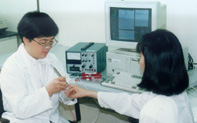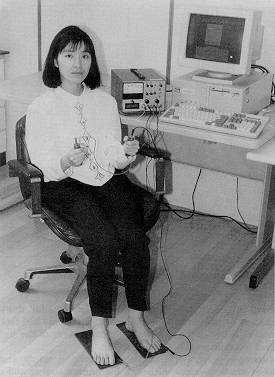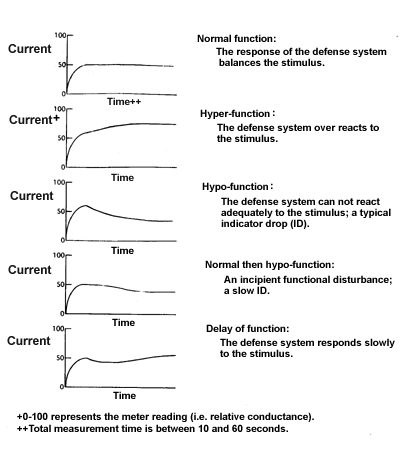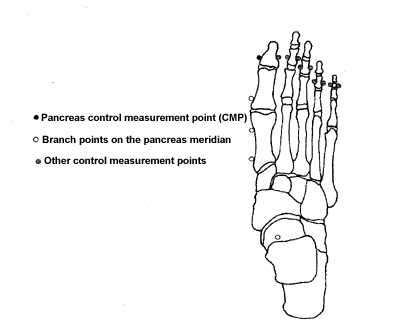Figure 1.
A simple schematic diagram of an EDSD.
Training in the use of the probe is essential (3). Point location must be accurate, and the probe must be applied at the correct angle. Appropriate pressure must be applied during measurement which may take as long as 60 seconds. This pressure can be from 600 to 2000 PSI depending on tip design and may create a temporary dimple. It may be slightly uncomfortable but should not be painful. Moistening the probe tip and the hand electrode ensures good electrical contact. Repeated measurements, the time taken for each and the time between them affects readings (16) (Figures 2 and 3).

Figure 2.
Photograph of a point measurement.

Figure 3.
Photograph of a patient during a four quadrants measurement.
Measuring involves two components, the initial reading, which is generally the highest, and what is known as the indicator drop (ID), a gradual fall in the original reading. An initial reading of aproximately 50, followed by little or no ID is considered to be "balanced." Initial readings over 60 may indicate inflammation of the connected system. Readings below 45 may indicate degeneration. When an ID is present it is considered to provide the most important information as an indi-cator of system disease. Using "medicine testing," the ID can be used to define the cause of imbalance (Figure 4).

Figure 4.
Five examples of typical readings taken with the EDSD.
There are 850 measurement points (4) on the body, but most mea-surements use points along 40 meridians on the hands and feet, gen-erally located between the diaphysis and capitulum of the phalanx, metacarpal or metatarsal bones (Figure 5).

Figure 5.
Examples of measurement point locations on the right foot.
Voll discovered new meridians, new measuring points and new functions of existing points, although his understanding and use of meridians was generally in agreement with Chinese tradition. His "new" meridians relate to joints, skin, fibrous and fatty tissues, se-rous membranes, pyramidal and autonomic nervous systems, lymph system, capillary circulation and allergic reactions.
Branch points, many of which were discovered by Voll, help in pin-pointing the exact location of abnormal function. For example, the branch points on the two heart meridians, one on each hand, include all the heart valves, the conduction system and coronary arteries. By combining readings from different points, a more exact definition of the affected tissue is possible.
The EDST begins with examination of whole-body energy levels
represented in 4 quadrants, hand-to-hand, foot-to-foot, right hand-to-foot and left hand-to-foot, using brass tube hand and brass plate foot electrodes. The probe is then used at the control measurement points (CMP) to determine the general condition of a meridian. Branch points are checked if there is a positive reading at the CMP or if symptoms suggest it, regardless of CMP readings. When an ID oc-curs, various reagents can be tested by placing them one by one on the test plate in the circuit in an effort to restore balance by abolish-ing the ID. Each reagent sample is sealed in a glass container.
Selection of test reagents is based on medical knowledge and experience and may require a combination. Reagents that abolish the ID may be found to be appropriate as a medication or as a nutritional supplement. No change suggests ineffective choice, while an increased ID suggests that the choice would be harmful. For example, in a diabetic, a proper dose of insulin would improve or abolish the ID, whereas refined sugar would increase it.
Medicine testing is controversial but may be the most promising aspect of the EDSS (12,13,17). Voll, who discovered the phenomenon, used it in conjunction with homeopathy and its effectiveness in testing homeopathic remedies has been published (16,18). They are particularly useful reagents since they are prepared in various dilutions which increases the likelihood of finding an appropriate "resonance," to be discussed below.
This kind of procedure has been shown to be effective in testing herbal and allopathic drugs (18,19) and is successful in testing for allergy (20,21), the presence of environmental xenobiotics like insecticides (22) and the effect of biologically active substances.
Theoretical Basis and Holistic Approach
The EDSS is based on electromagnetic physics and quantum mechanics and this is well documented (23-25). Bio-energy, bio-information and harmonic resonance represent the biophysical foundation of its use. All living creatures generate energy containing biological information which flows in specific tracks throughout the organism. The cell mass in a given organ creates informational energy when the organ functions, giving rise to resonance. There is therefore a direct relationship between quality of organ function and the energy generated.
The initial reading in the EDST measures the energy generated by the connected system. The form and time elapsed in the ID and its manipulation through medicine testing represent the information contained. If system function is normal there will be electrical equilibrium between the EDSD generated voltage and the system. There will be no ID. On the other hand, if the system cannot maintain equilibrium, resistance will increase and there will be an ID. During medicine testing, it is the informational energy in the reagent that causes equilibrium to be established, thus abolishing the ID.
Bio-energy and its relationship with acupuncture points and meridians has been confirmed (26-28). Areas of increased electrical conductivity on the skin are known to correspond with them
(29-32) and scintillation scanning of radioactive tracers injected at acupuncture points reveals patterns of energy flow separate from blood and lymph circulation (33). A definite relationship has been shown to exist between a meridian and its associated system and other bio-energetic relationships have been found to exist between the exterior and interior of the body (34-38).
Bio-information research is new, but all matter has its own unique vibratory signal (39). It is possible to record the vibrational information of a given substance in water and use the water for treatment (40,41), information which can also be carried by photon and electron beams (42). Storage and transport of this information is almost certainly biophysical rather than biochemical, though its exact nature is still uncertain. Theories include L-fields (43) and biophoton emission (44). A plausible mechanism for medicine testing has been suggested (45) based upon quasi phase matching, or resonance, between the test system and the reagent. Chen (personal communication) has suggested that all biological systems communicate through similar quantum-mechanical processes.
(Excerpted from Journal of Advancement in Medicine, Volume 8, Number 4, Winter 1995)
|